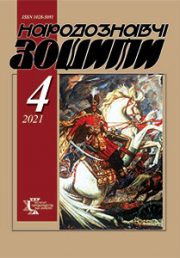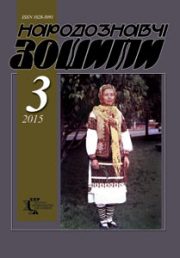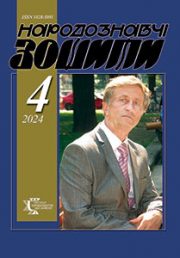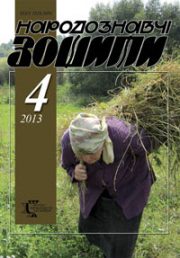The Ethnology Notebooks. 2021. # 2 (158), P. 404—423
УДК [391-055.2:687.4.016:7.04](477.85)
DOI https://doi.org/10.15407/nz2021.02.404
Olena NYKORAK
- Doctor in Art Studies, Professor,
- Leading Researcher at Folk Art Department
- of Ethnology Institute of the National Academy
- of Sciences of Ukraine,
- 15, Svobody Avenue, 79000, Lviv, Ukraine,
- e-mail: olenanykorak@gmail.com
Introduction. Artistic and aesthetic features of patterned namitkas of Bukovynian Podillia are analyzed. Bukovynian namitkas decoration system distinguishes them from similar items of other regions of Ukraine in a unique artistic phenomenon. The lack of a detailed study of typical features namitkas` woven décor of this area determined the relevance and the novelty of the study.
The paper purpose — artistic features of namitkas` woven ornament from the studied territory of Northern Bukovyna at the end of the XIX — the middle of the XX centuries as significant phenomenon of Ukrainian decorative art are revealed.
The object of research is patterned woven from namitkas Bukovynian Podillia, and the subject — reflection of traditional features and factors that form the local identity of compositional features, motifs of ornament, colour.
Methodological basis of the paper is the principle of systematic. Formal-typological method, art analysis, interviewing and photo-fixation were used.
The source base for writing this paper was the publications of Ukrainian ethnographers and art critics, items from museums and private collections and museum rooms at schools and libraries, as well as the author’s field research.
Keywords: burunchuk namitkas, Bukovynian Podillia, decor, composition schemes, motifs, colour.
REFERENCES
- Kolbenhaier, Е., & Hribka, Vasyl and Oleksa (Eds.). (2008). Pattern of Craft in Bukovina (in the period from 1902 to 1912). Chernivtsi: Kolir-Druk [in Ukrainian].
- Kaindl, R.F. (2000). Hutsuls: Their Lives, Traditions and Folk Tales. Chernivtsi [in Ukrainian].
- Mateiko, K.I. (1977). Ukrainian Folk Clothing. Kyiv: Naukova Dumka [in Ukrainian].
- Mateiko, K.I. (1996). Ukrainian Folk Clothing: Ethnographic Dictionary. Kyiv: Naukova Dumka [in Ukrainian].
- Mateiko, K.I. (1973). Headwear of Ukrainian Peasants of the Beginning of the XX century. Folk Art and Ethnography, 3, 47—54 [in Ukrainian].
- Sydorovych, S. (1979). Art Fabrics of UkrSSR Western Regions. Kyiv: Naukova Dumka [in Ukrainian].
- Kostyshyna, M.V. (1996). Ukrainian Folk Costume of Northern Bukovyna. Traditions and Modernity. Chernivtsi: Ruta [in Ukrainian].
- Bilan, M. S., Stelmashchuk, H. H. (2000). Ukrainian Clothing. Lviv: Apriori [in Ukrainian].
- Stelmashchuk, H.H. (2013). Ukrainian Folk Headdresses (2nd ed.) Lviv: Apriori [in Ukrainian].
- Kosmina, O.U. (2008). Traditional Clothing of Ukrainians: in 2 vol. Forest-steppe. Steppe (Vol. 1). Kyiv: Baltia-Druk [in Ukrainian].
- Fedorchyk, O.S. (2008). Beads in Folk Clothing Décor of Bukovynians (based on the materials of art expeditions 2007—2008). The Ethnology Notebooks, 5—6, 540—551 [in Ukrainian].
- Fedorchyk, O. (2014). Beads Decor of Folk Clothing of Bukovyna of the First Half of the XX Centuries. The Ethnology Notebooks, 5, 984—997 [in Ukrainian].
- Kozhelianko, Ia.I. (1994). Bukovynian Traditional Clothing. Chernivtsi; Saskatun: Bukovyna [in Ukrainian].
- Kozhelianko, H.K. (1999). Ethnography of Bukovyna: in 3 vol. (Vol. 1). Chernivtsi: Zoloti Lutavry [in Ukrainian].
- Golovatskiy, Ya. (1877). Golovatsky Ya. On the folk clothes and the decoration of Rusins or Russians in Galicia and Northeast Hungary. St. Peterburg: Tipografіya V. Kirshbauma, v d. Minister. Fin., na Dvorts. Ploshch [in Russian].
- Vovk, Khv. (1995). Studies from Ukrainian ethnography and anthropology. Kyiv: Mystetstvo [in Ukrainian].
- Voropai, O. (1966). The Costums of Our People. Essays on Ukrainian Ethnography and Folk-lore: in 2 vol. (Vol. II) [in Ukrainian].
- Zelenchuk, V.S. (1985). Moldovan national costume. Chisinau: Timpul [in Russian].
- Postolaki, E. (1987). Moldovan Folk Weaving (ХІХ — Early ХХ cc.). Chisinau: Shtiintsa [in Russian].
- (1955). Research team of the Museum of Folk Art of RNR (Eds.) Romanian folk art. Bucharest: Izdatelstvo rumyinskogo instituta kulturnoy svyazi s zagranitsey [in Russian].
- Banateanu Tancred, Focsa Gheorhe, & Ionescu Emilia. (1958). Folk Art in the Rumanian People’s Republic. Costumes. Woven Textile. Embroideries. Bucureşti: State Publishing House for Litterature and the Arts [in Romanian].







